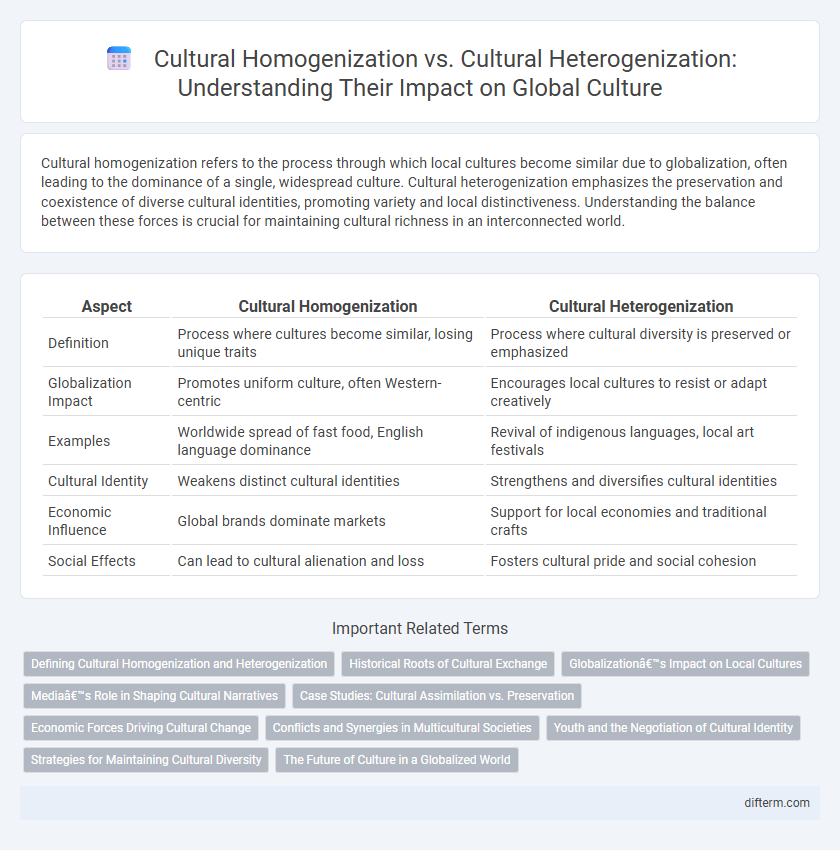Cultural homogenization refers to the process through which local cultures become similar due to globalization, often leading to the dominance of a single, widespread culture. Cultural heterogenization emphasizes the preservation and coexistence of diverse cultural identities, promoting variety and local distinctiveness. Understanding the balance between these forces is crucial for maintaining cultural richness in an interconnected world.
Table of Comparison
| Aspect | Cultural Homogenization | Cultural Heterogenization |
|---|---|---|
| Definition | Process where cultures become similar, losing unique traits | Process where cultural diversity is preserved or emphasized |
| Globalization Impact | Promotes uniform culture, often Western-centric | Encourages local cultures to resist or adapt creatively |
| Examples | Worldwide spread of fast food, English language dominance | Revival of indigenous languages, local art festivals |
| Cultural Identity | Weakens distinct cultural identities | Strengthens and diversifies cultural identities |
| Economic Influence | Global brands dominate markets | Support for local economies and traditional crafts |
| Social Effects | Can lead to cultural alienation and loss | Fosters cultural pride and social cohesion |
Defining Cultural Homogenization and Heterogenization
Cultural homogenization refers to the process where diverse cultures become increasingly similar due to globalization, leading to the dominance of a few cultural practices and values worldwide. In contrast, cultural heterogenization emphasizes the persistence and emergence of local identities, traditions, and customs that resist uniformity and celebrate diversity. These opposing phenomena illustrate how globalization simultaneously promotes both cultural convergence and the preservation of unique cultural expressions.
Historical Roots of Cultural Exchange
Historical roots of cultural exchange trace back to ancient trade routes like the Silk Road, which facilitated cultural homogenization by spreading technologies, languages, and religions across continents. Simultaneously, localized adaptations and the blending of indigenous traditions fostered cultural heterogenization, preserving unique social identities. These dual processes shaped global cultural landscapes by intertwining shared influences with distinct regional characteristics.
Globalization’s Impact on Local Cultures
Globalization accelerates cultural homogenization by spreading dominant cultural norms, languages, and consumer practices worldwide, often overshadowing indigenous traditions. Conversely, cultural heterogenization emerges as local communities adapt global influences to reinforce unique identities and diversify cultural expressions. This dynamic interplay shapes global cultural landscapes, balancing uniformity and diversity through continuous negotiation between global forces and local resilience.
Media’s Role in Shaping Cultural Narratives
Media plays a pivotal role in cultural homogenization by disseminating dominant cultural values and norms globally, often marginalizing local traditions and languages. Conversely, media also fosters cultural heterogenization by providing platforms for diverse voices and localized content that celebrate unique identities and resist uniformity. The interplay between global media conglomerates and independent media outlets shapes cultural narratives, influencing how societies perceive and preserve their heritage amidst globalization.
Case Studies: Cultural Assimilation vs. Preservation
Cultural homogenization often leads to the assimilation of minority groups, as seen in the case of Native American communities facing the erosion of traditional languages and customs due to dominant Western cultural influences. Conversely, cultural heterogenization promotes preservation efforts, such as the revitalization of the Maori language in New Zealand, demonstrating resilience through educational programs and policy support. These contrasting outcomes highlight the tension between global cultural convergence and local identity maintenance in contemporary societies.
Economic Forces Driving Cultural Change
Economic forces driving cultural change significantly influence the dynamics between cultural homogenization and heterogenization. Globalization of markets and multinational corporations promotes cultural homogenization by spreading consumer products, media, and lifestyles, creating shared cultural experiences worldwide. Conversely, local economies and niche markets foster cultural heterogenization by sustaining indigenous traditions, crafts, and regional identities against the pressure of global economic integration.
Conflicts and Synergies in Multicultural Societies
Cultural homogenization often leads to conflicts as dominant cultural norms may suppress minority identities, sparking social tensions and resistance. However, cultural heterogenization fosters synergies by promoting diversity, intercultural dialogue, and mutual understanding, which can enhance social cohesion and innovation. Multicultural societies balance these dynamics by negotiating between preserving unique cultural expressions and embracing shared values to reduce conflicts and maximize collaborative benefits.
Youth and the Negotiation of Cultural Identity
Youth navigate cultural identity amid global cultural homogenization driven by mass media and digital connectivity, which often promotes dominant cultural norms and values. In response, cultural heterogenization emerges as young people actively negotiate, resist, and reinterpret cultural influences, creating hybrid identities that blend local traditions with global trends. This dynamic interplay shapes evolving youth cultures that challenge monolithic cultural narratives and emphasize diversity within globalization.
Strategies for Maintaining Cultural Diversity
Strategies for maintaining cultural diversity emphasize promoting multilingual education and supporting indigenous art forms to counter cultural homogenization driven by globalization. Implementing policies that protect minority languages and traditions fosters cultural heterogenization by encouraging local identity and heritage preservation. Cultural institutions and community programs play a crucial role in sustaining diverse cultural expressions through inclusive representation and intercultural dialogue.
The Future of Culture in a Globalized World
Cultural homogenization threatens unique traditions as global media and technology promote dominant cultural norms, leading to widespread uniformity. Conversely, cultural heterogenization fosters diversity by allowing local cultures to adapt and reinterpret global influences, preserving distinct identities. The future of culture in a globalized world hinges on balancing these forces to maintain cultural richness and innovation.
Cultural homogenization vs Cultural heterogenization Infographic

 difterm.com
difterm.com